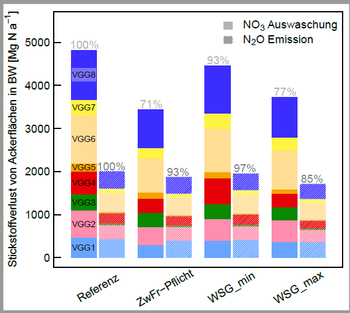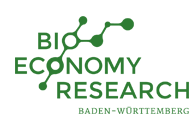Sustainable biomass supply for the bioeconomy in Baden-Württemberg

The aim of the research project was a model-based assessment of the economic and ecological sustainability of biomass production in Baden-Württemberg. The focus was on the supply of perennial crops for value chains of the bioeconomy. During the project, model interfaces were developed between the ecosystem model DAISY, the regional supply model for agriculture in Baden-Württemberg EFEM (Economic Farm Emission Model) and a life cycle assessment model (LCA). This resulted in a model network that was used to evaluate various ecological and economic scenarios holistically. The Agro‐Ecological Regions (AER) served as regional subdivisions of Baden-Württemberg (BW). The LCA showed that miscanthus cultivation in the fertile arable regions of BW causes the lowest relative environmental impacts per kg of biomass in almost all impact categories considered. Using water protection scenarios, the effect of the perennial crop Miscanthus in water protection areas on nitrate (NO3) leaching and indirect nitrous oxide (N2O) emissions was analysed. Another scenario was the compulsory cultivation of catch crops before summer crops (ZwFr-obligation). The figure shows that the NO3 reduction potential of catch crop cultivation (-29%) is slightly higher than in the WSG_max scenario (-23%), in which the entire water protection area would be cultivated by miscanthus (approx. 260,000 ha). In contrast, N2O emissions would decrease more due to the cultivation of miscanthus. In scenario WSG_min, in which Miscanthus would only be cultivated in the catchment area and in the narrower protection zones of the water protection areas (approx. 13,500 ha), NO3 leaching would only be reduced by approx. 7 %. However, even in this scenario, NO3 leaching in the sensitive water protection areas would be significantly reduced, which would lead to a massive improvement in water quality. The economic evaluation of the scenarios has shown that, especially in the good arable farming locations, the NO3 avoidance costs are very low and, under the scenario assumptions made, avoidance gains can sometimes arise. At the same time, however, it could be shown that a large area of Miscanthus cultivation can lead to a displacement of fodder and food production. If consumption structures are not changed, the positive ecological effects of miscanthus cultivation could be displaced by the import of these products (leakage effect).
| Project title | Sustainable biomass supply for the bioeconomy in Baden-Württemberg – an economic and ecological analysis |
| Institutions and researcher | University of Hohenheim, Institute of Farm Management University of Hohenheim, Biobased Products and Energy Crops University of Freiburg, Hydrological Chairs |
